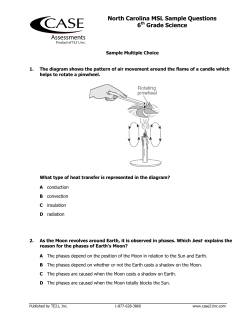
Lab 5: Photosynthesis
Lab 5: Photosynthesis Lab 5: Photosynthesis Lab 5: Photosynthesis Leaves float in water due to presence of air (air spaces) in the leaf. How does one get them to sink? Lab 5: Photosynthesis Put leaf discs under vacuum by placing them in an aqueous solution inside a syringe, cover the hole of the syringe with your thumb, and then pull back on the syringe…negative pressure…sucks air out of leaf (fig 6a). Disks will sink (fig. 6b). Lab 5: Photosynthesis We want leaf discs to still be able to do photosynthesis in the solution…but you just removed the air and replaced it with water, which has little dissolved CO2…what can we add to the water to put lots of dissolved CO2? Lab 5: Photosynthesis Na+HCO3- (sodium bicarbonate) ADD BAKING SODA… Na+HCO3- dissociates in aqueous solution to Na+ + HCO3HCO3- + H3O+ <-> H2CO3 + H2O H2CO3 <-> H2O + CO2 Lab 5: Photosynthesis Now hit them with light…what happens? They will float after some amount of time because O2 is being produced by photosynthesis. However, this is only an INDIRECT method of measuring CO2 rate…why? Cell Respiration is occurring, using some of the O2 and producing CO2 gas as so you are actually also observing cell resp though the amount of CO2 = O2 used… Lab 5: Photosynthesis Review… Lab 5: Photosynthesis http://www.youtube.com/watch?v=ZnY9_wMZZWI Lab 5: Photosynthesis What is the dependent variable in this experiment? The time it takes for each disk to float. This is what you are measuring. What shall we test (the independent variable)? Let’s test the amount of CO2 dissolved in the water!!!! Lab 5: Photosynthesis Why is dilute soap being added in step 3? The cuticle of the leaf is hydrophobic and prevents the leaf discs from ever sinking. The soap, as you know, is amphiphilic (its essentially a fatty acid). It will coat the leaf discs (tails interacts with cuticle and carboxyl head interacts with water). This will allow the discs to sink after the gas is sucked out. Lab 5: Photosynthesis Why is dilute soap being added in step 3? The “grease particle” in this case are the leaf discs… Lab 5: Photosynthesis Prepare the disks… Lab 5: Photosynthesis Prepare the disks… - One set of ten gets degassed in pure water (control) - One set of ten gets 0.2% bicarbonate (experimental group) Lab 5: Photosynthesis Place both cups under the light source… Lab 5: Photosynthesis The ET50 (Estimated Time it takes for 50% of disks to float…median) The ET50 is the estimated time it takes for 50% of the disks to float, which has been shown to be a reliable measure to compare between experiments if you repeat this… Lab 5: Photosynthesis Class Data Every group should have a chart like this, but with two lines…one for pure water and one for 0.2% bicarbonate solution from which they will determine the ET50 for both. Lab 5: Photosynthesis Class Data Trials ET50 – Pure Water (s)_ ET50 – 0.2% bicarbonate (s) 1 415 388 2 420 364 3 408 371 4 395 395 5 424 410 6 398 381 7 416 379 8 410 405 Here is our data…now what do we do to analyze it and see if there if a difference between these two groups? Lab 5: Photosynthesis Class Data Histogram indicating the distribution of ET measurements in a baby leaf spinach disk assay 50 3.5 Frequency of trials 3 Blue – pure water Green – 0.2% bicarbonate 2.5 2 1.5 1 0.5 0 361-370 371-380 381-390 391-400 ET50 (s) Now what? 401-410 411-420 421-430 Lab 5: Photosynthesis Class Data Trials ET50 – Pure Water (s)_ ET50 – 0.2% bicarbonate (s) 1 415 388 2 420 364 3 408 371 4 395 395 5 424 410 6 398 381 7 416 379 8 410 405 MEAN SD (σ) SE Lab 5: Photosynthesis Class Data Make sure you recall the meaning of the standard deviation and standard error. And now… Trials ET50 – Pure Water (s)_ ET50 – 0.2% bicarbonate (s) 1 415 388 2 420 364 3 408 371 4 395 395 5 424 410 6 398 381 7 416 379 8 410 405 MEAN 410 387 SD (σ) 10.2 16.0 SE 3.60 5.67 Lab 5: Photosynthesis 420 Class Data 410 Time (s) 400 390 380 370 360 Pure Water 0.2% Bicarbonate Figure X. Mean ET50 values for leaf disks evacuated and submerged in pure water and 0.2% bicarbonate solution. Error bars indicate standard error for eight trials (n=8). Lab 5: Photosynthesis Lab 5: Photosynthesis Lab 5: Photosynthesis
© Copyright 2025











